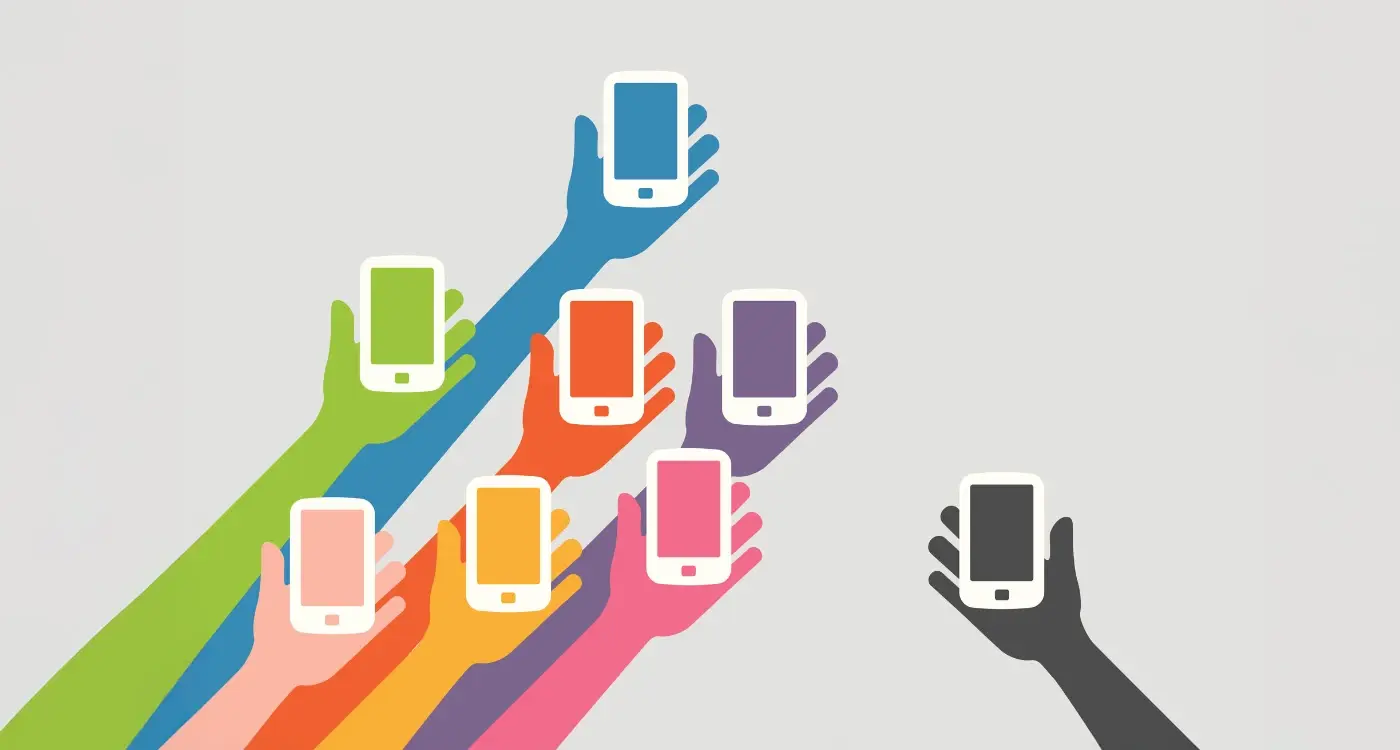What Makes Some Apps Beat Their Rivals Every Time?
Two dating apps launch within months of each other. Both have attractive interfaces, similar core features, and decent funding behind them. One becomes a household name with millions of active users; the other shuts down after eighteen months of struggling to gain traction. What made the difference? It wasn't luck—it was understanding what actually makes users choose one app over another.
I've been building mobile apps for startups and Fortune 500 companies for over eight years now, and I've seen this scenario play out countless times across every industry you can think of. The apps that succeed aren't necessarily the ones with the biggest budgets or the flashiest features. They're the ones that understand their competitive advantage and execute it properly.
Here's what most people get wrong about app success: they think it's about having a brilliant idea that nobody's thought of before. But honestly? There are very few truly original ideas left in the app world. What matters is how you execute that idea differently from everyone else who's already doing something similar.
Success in the app market isn't about being first—it's about being better at solving problems your users actually care about.
The apps that beat their rivals consistently do a few things really well. They understand exactly who they're competing against, they know what makes them different, and they focus relentlessly on the user experience details that their competitors ignore. Most importantly, they build app success factors into their strategy from day one rather than hoping things will work out.
This guide will show you exactly how to identify and implement the competitive advantages that separate winning apps from the millions that get downloaded once and forgotten. No fluff, no theory—just practical strategies that actually work in today's crowded app marketplace.
Understanding Your Competition Before You Build
Right, let's talk about something most app founders get completely wrong—they build first and research later. It's backwards, honestly. I've watched countless clients come to me with half-built apps, wondering why their downloads are flatlining, only to discover they never properly looked at what they're up against.
Here's the thing about competition research; it's not just about downloading your rivals apps and having a quick scroll through. That's surface-level stuff. You need to dig deeper—read their reviews (especially the negative ones), check their update frequency, see how they respond to user complaints. The App Store reviews are pure gold for understanding what users actually want versus what developers think they want.
What Your Rivals Are Doing Right
I always tell my clients to spend at least a week using their competitors apps daily. Not just poking around, but genuinely trying to complete real tasks. You'll quickly spot the friction points, the features that feel clunky, and—more importantly—the bits that work brilliantly and keep you coming back.
Pay attention to their onboarding process too. How many steps does it take to get to value? Do they ask for permissions upfront or wait until they're needed? These details matter more than you might think, and they often vary significantly depending on how industry type affects your mobile app development budget and target audience expectations.
Spotting the Gaps
The best opportunities aren't always about building something completely new—sometimes its about taking what already exists and doing it better. Maybe your competitors have great functionality but terrible user experience. Or perhaps they're feature-rich but overwhelming for new users. That's your opening right there.
Don't just look at direct competitors either. Sometimes the biggest threat comes from apps in adjacent spaces that could easily expand into your territory.
Finding Your Unique Selling Point
You know what? After building apps for nearly a decade, I can tell you that most app failures come down to one simple problem—people can't figure out why their app matters. Sure, it might work perfectly and look great, but if users can't immediately understand what makes it different from the fifty other similar apps, you're in trouble.
I see this all the time with new clients. They'll come to me with an idea for a fitness app or a task manager, and when I ask what makes theirs special, they start listing features. But here's the thing—features aren't what make apps successful. Your unique selling point isn't about what your app does; it's about why someone would choose yours over everything else available.
The best way to find your unique angle is to look at what existing apps in your space are doing wrong or ignoring completely. I worked on a meditation app recently where the client noticed that all the popular apps were quite serious and clinical. Their unique selling point? Making mindfulness fun and approachable for people who thought meditation was "too hippie" for them. That simple insight shaped everything from the design to the marketing.
Write down your app idea in one sentence, then ask five strangers to explain it back to you. If they can't, your unique selling point isn't clear enough yet.
Common Unique Selling Points That Actually Work
- Solving the same problem but for a specific group (busy parents, students, small business owners)
- Combining two separate functions that people usually need different apps for
- Making something complicated much simpler than competitors
- Focusing on privacy when others collect lots of data
- Being the budget-friendly option that still works well
- Offering offline functionality when others require internet
Your unique selling point should be something you can explain in ten seconds or less. If it takes longer than that, you're probably overthinking it—and more importantly, your potential users won't stick around long enough to understand why they should care about your app.
User Experience That Actually Works
Here's what I've learned after building hundreds of apps—good UX isn't about making things pretty; it's about making things work so well that users don't even think about it. When someone opens your app and immediately knows what to do next, that's not luck. That's careful design.
The best apps I've built follow what I call the "three tap rule"—users should be able to complete their main task within three taps of opening the app. Any more than that and you'll start losing people. It's harsh but true. People's attention spans are shorter than ever, and if your app makes them work too hard, they'll find something else.
The Basics That Most Apps Get Wrong
Loading screens are death. I mean it—every extra second your app takes to load increases the chance someone will close it and never come back. We always optimise for speed first, then add features. The opposite approach kills apps faster than anything else I've seen.
Navigation needs to be obvious without being boring. Sure, everyone knows what a hamburger menu does now, but that doesn't mean it's always the right choice. Sometimes a simple bottom tab bar works better, especially if your app has three to five main sections that users switch between regularly.
- Keep your main actions visible on the home screen
- Use familiar icons and don't try to reinvent basic symbols
- Test your app with people who've never seen it before
- Make buttons big enough to tap easily (especially for older users)
- Provide feedback when users complete actions
One thing that really bothers me? Apps that ask for permissions immediately. Nobody wants to give camera access to an app they haven't even used yet. Wait until users actually need that feature, then explain why you need it. Context makes all the difference between "allow" and "not now"—trust me on this one.
Building Features That Users Need
Here's where I see most apps go wrong—they build features they think are clever rather than features users actually want. I mean, it sounds obvious when you say it like that, but you'd be surprised how many clients come to me with a list of "must have" features that nobody asked for.
The trick is starting with user problems, not app features. What's keeping your target users up at night? What makes them frustrated during their day? What takes them way longer than it should? Once you understand these pain points, the features you need to build become pretty obvious.
I always tell my clients to focus on doing one thing really well before trying to do ten things poorly. Look at WhatsApp—it started as just messaging. That's it. No stories, no payments, no business accounts. Just simple, reliable messaging that worked better than SMS. They nailed that core feature first, then built everything else around it.
The best features solve problems users didn't even realise they had until they experienced the solution
User research is your best friend here, but it doesn't have to be complicated or expensive. Talk to potential users. Watch how they currently solve the problem your app addresses. What workarounds are they using? What steps do they find annoying? These conversations will give you more useful insights than any amount of guessing.
And here's something that might sound counterintuitive—sometimes the best feature is removing a feature. If users aren't engaging with something, get rid of it. Every feature you keep has to earn its place by making the app better, not just different from your competitors.
Getting Your App Discovery Strategy Right
Right, let's talk about something that keeps many app developers up at night—getting people to actually find your app. You could build the most brilliant app in the world, but if nobody knows it exists, you're basically shouting into the void. And trust me, I've seen some genuinely fantastic apps disappear without a trace because their discovery strategy was, well, non-existent.
App store optimisation is your first port of call here. Think of your app's listing as your shop window—people need to understand what you're selling within seconds of seeing it. Your app title, description, and screenshots need to work together to tell a clear story. I see so many apps with vague names like "MyApp" or descriptions that read like technical manuals. Nobody's searching for that stuff!
But here's where it gets tricky—app stores aren't your only discovery channel anymore. Social media, content marketing strategies that drive app downloads, influencer partnerships, even good old-fashioned word of mouth can drive more downloads than store features these days. The most successful apps I've worked on had discovery strategies that started months before launch.
Key Discovery Channels Worth Your Time
- App Store Optimisation (keywords, visuals, reviews)
- Social media marketing and community building
- Content marketing and SEO for your website
- Partnerships with complementary businesses
- PR outreach to relevant publications
- Beta testing programs that create early advocates
One thing that really works? Building an audience before you build the app. Create content around the problem you're solving, engage with potential users on social platforms, start conversations. When your app launches, you'll already have people waiting for it rather than trying to find them afterwards. Don't forget to research which hashtags work best for promoting your mobile app to maximize your social media reach.
Keeping Users Coming Back For More
Right, let's talk about something that keeps most app owners up at night—user retention. You can have the most beautiful app in the world, but if people download it and never open it again, you're basically throwing money down the drain. And trust me, I've seen this happen more times than I'd like to count.
The harsh reality? Most apps lose 80% of their users within the first three days. That's not a typo—it's genuinely that brutal out there. But here's the thing: the apps that crack this retention puzzle are the ones that dominate their markets. They build habits, not just functionality.
User retention starts with your onboarding experience. I mean, really starts there. If someone downloads your app and can't figure out its value within the first 30 seconds, they're gone. Your onboarding should be like a good joke—if you have to explain it too much, you've already lost them.
Focus on showing value before asking for anything. Don't make users create accounts or fill out forms before they understand what your app actually does for them.
Push Notifications That Don't Push Users Away
Push notifications are your direct line to users, but they're also the fastest way to get deleted. The apps that win use notifications strategically—they provide value, not interruption. Think progress updates, personalised recommendations, or genuine utility.
- Send notifications based on user behaviour patterns
- Allow granular control over notification types
- Time notifications when users are most likely to engage
- Use clear, actionable language that creates curiosity
- Test different messaging styles and track open rates
Building Habit-Forming Features
The most successful apps create genuine habits. They become part of users daily routines rather than occasional tools. This happens through consistent value delivery—solving the same problem reliably, every single time. Whether its checking the weather, tracking fitness, or managing finances, users return because your app becomes indispensable to their routine.
App Store Success and Rankings
Right, let's talk about the app stores—because honestly, this is where most people get it completely wrong. I've watched brilliant apps disappear into the void while mediocre ones somehow climb the rankings, and it's rarely down to luck.
The app stores aren't just digital shelves where you plop your app and hope for the best. They're complex ecosystems with their own rules, and those rules have changed dramatically over the years. Apple and Google now look at dozens of factors when deciding which apps to show users, and download numbers are just one piece of the puzzle.
What Actually Affects Your Rankings
Here's what the algorithms really care about these days:
- User retention rates (how many people keep using your app after downloading)
- App quality signals like crash rates and loading times
- User reviews and ratings (but not just the star count)
- Keywords in your app title and description
- How often people search for your app by name
- Conversion rates from your app store listing
The thing is, you can't game these metrics anymore. Well, you can try, but it won't work long-term. I've seen companies spend thousands on fake reviews only to get their apps removed entirely. The stores have gotten much smarter about detecting manipulation.
Getting Your Store Listing Right
Your app store listing is basically your shop window. Most people decide whether to download your app within seconds of seeing it, so every element matters. Your screenshots need to show your app's best features immediately—not after someone swipes through five images. Your description should focus on benefits, not features. And your app icon? It needs to stand out in a sea of similar-looking squares.
But here's the thing that trips up most developers: app store optimisation isn't a one-time job. You need to keep testing different screenshots, tweaking your keywords, and responding to user feedback. The apps that consistently rank well treat their store presence like a living, breathing marketing campaign. For Android apps specifically, implementing a complete Play Store optimisation strategy can make the difference between visibility and obscurity.
Conclusion
After years of building apps and watching some soar whilst others crash and burn, I can tell you that success in the mobile world isn't about luck. It's about understanding what truly matters to users and delivering it better than anyone else. The apps that consistently beat their rivals? They don't just tick boxes—they solve real problems in ways that feel almost magical to the people using them.
The mobile app strategy that works best is the one that puts users first, not features. I've seen too many apps fail because they got caught up in what they thought was cool rather than what was actually useful. Your competitive advantage comes from knowing your users better than your competitors do and building something that genuinely makes their lives easier or better in some small way.
App differentiation isn't about having the most features or the flashiest design; its about doing the right things exceptionally well. The most successful apps I've worked on have been the ones where we really understood why people would choose us over the dozens of alternatives available to them. They had clear app success factors that we could measure and improve over time, and we always considered the real costs of app store optimisation as part of our long-term strategy.
Building a winning app is part science, part art, and a good chunk of common sense. Focus on solving a real problem, make the experience delightful, and never stop listening to your users. The apps that beat their rivals every time are the ones that remember mobile is personal—you're literally in someone's pocket, so you better be worth the space you're taking up.
Share this
Subscribe To Our Learning Centre
You May Also Like
These Related Guides

How Can Small Apps Compete With Industry Giants?

How Do I Position a Second App in the Same Category?



